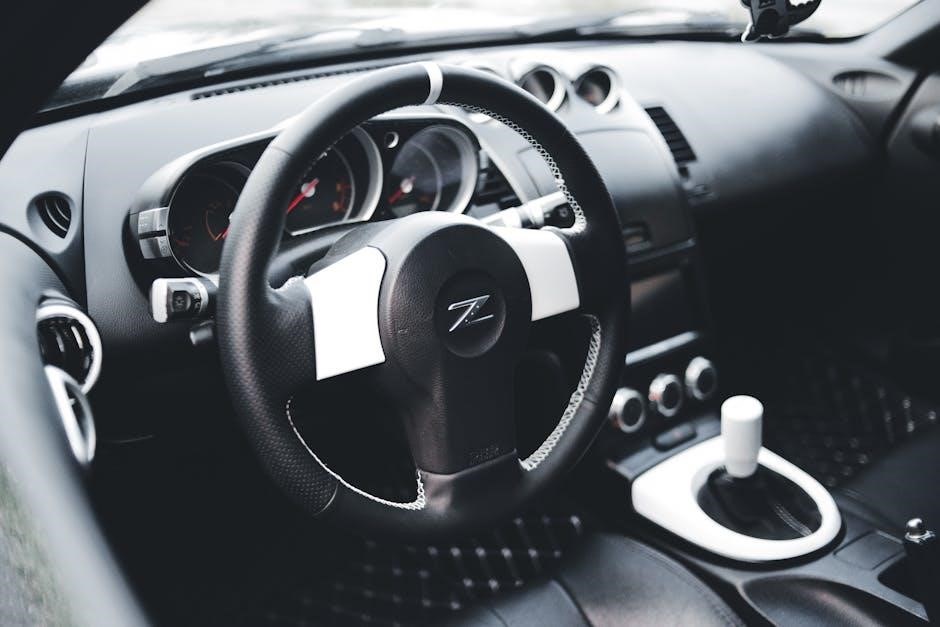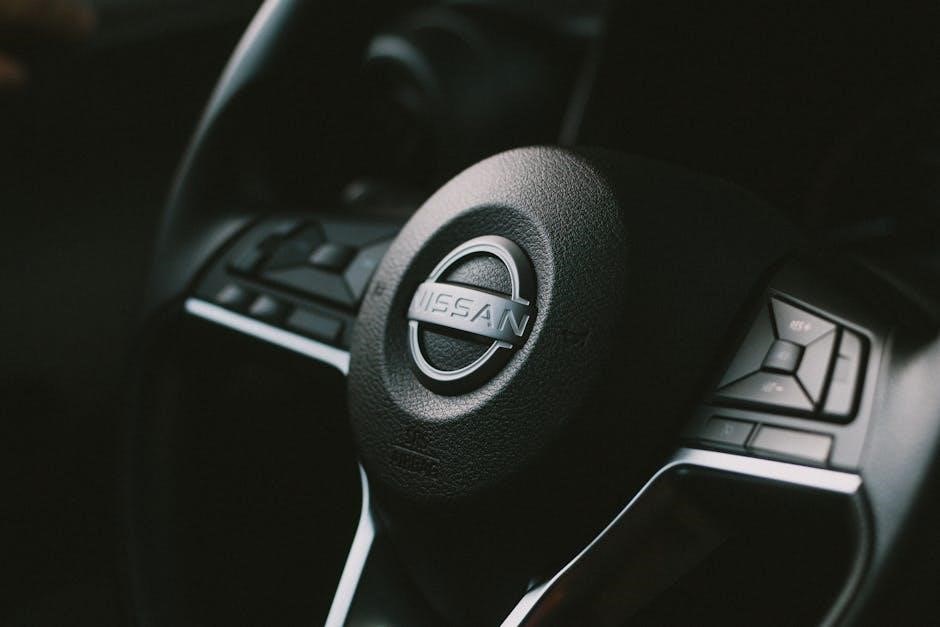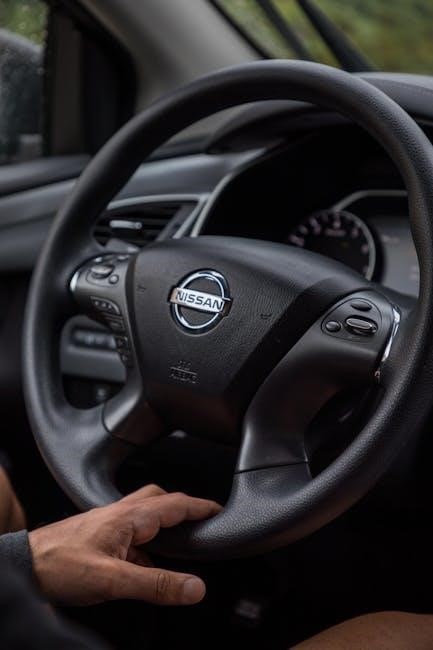The Nissan Altima with a manual transmission offers a unique driving experience, popular among enthusiasts for its fuel efficiency, precise control, and timeless driver engagement․
1․1 Overview of Nissan Altima Manual Transmission Models
The Nissan Altima has offered several manual transmission models over the years, catering to drivers who prefer hands-on control․ The base S and sporty SR trims often feature a 6-speed manual gearbox, providing crisp shifts and enhanced driver engagement․ Special editions, such as the Track and Performance packages, also include manual options for enthusiasts․ These models are praised for their fuel efficiency, cost-effectiveness, and responsive acceleration, making them a popular choice for both daily commuting and spirited driving․ The manual transmission in the Altima delivers a more connected driving experience compared to its automatic counterparts․
1․2 Importance of Manual Transmissions in Driving Experience
Manual transmissions in the Nissan Altima play a crucial role in enhancing the driving experience by offering enhanced control and driver engagement․ They provide a more direct connection to the vehicle, allowing drivers to feel more involved in the driving process․ This hands-on approach not only improves fuel efficiency but also offers a cost-effective option for both purchase and maintenance․ For driving enthusiasts, the manual transmission fosters a deeper emotional satisfaction and a more rewarding experience behind the wheel․ It’s a testament to the timeless appeal and enduring satisfaction of manual driving in the Altima lineup․

History of Manual Transmission in Nissan Altima
The Nissan Altima’s manual transmission debuted in the 90s, offering improved performance and fuel efficiency․ Over the years, it evolved to enhance reliability and driver satisfaction, becoming a hallmark of the model․
2․1 Evolution of Manual Transmission in Nissan Altima Over the Years
The manual transmission in the Nissan Altima has undergone significant advancements since its introduction․ Early models featured a basic 5-speed system, which provided reliable performance and fuel efficiency․ By the mid-2000s, the Altima offered a refined 6-speed manual, enhancing driver control and responsiveness․ Over the years, Nissan incorporated improvements such as smoother gear transitions, reduced vibrations, and better synchronization․ These updates aimed to deliver a more engaging and efficient driving experience․ The manual transmission remained a popular choice for enthusiasts until its discontinuation in later model years, marking the end of an era for this beloved feature․
2․2 Key Milestones in the Development of Manual Transmissions
The development of the Nissan Altima’s manual transmission has been marked by several key milestones․ Initially introduced in the early 1990s with a 5-speed system, it quickly gained popularity for its responsiveness․ By the mid-2000s, Nissan upgraded to a 6-speed manual, offering smoother shifting and improved fuel efficiency․ The addition of features like close-ratio gearing and refined synchronizers further enhanced performance․ Later models incorporated lightweight materials and optimized gear ratios for better acceleration․ These advancements solidified the Altima’s reputation as a driver-focused vehicle, catering to enthusiasts who valued precise control and engaging driving dynamics․

How Manual Transmission Works in Nissan Altima
The Nissan Altima’s manual transmission operates by engaging gears manually via a clutch pedal and shifter․ Pressing the clutch disengages the engine from the transmission, allowing smooth gear shifts to transfer power efficiently to the wheels․
3․1 Basic Components of a Manual Transmission System
A manual transmission system in the Nissan Altima consists of key components that work together to enable smooth gear shifts․ The clutch is central, disconnecting the engine from the transmission when pressed․ The gearbox houses the gears, which are selected using the shifter․ The input shaft connects to the clutch, while the output shaft sends power to the wheels․ Bearings and synchronizers ensure smooth engagement of gears, and the gear ratios are designed for optimal performance across driving conditions․
3․2 Understanding the Clutch Mechanism
The clutch in a Nissan Altima manual transmission is a critical component that enables seamless gear shifts․ When the driver presses the clutch pedal, it disengages the engine from the transmission, allowing the driver to shift gears without grinding․ The clutch consists of a flywheel, clutch disc, and pressure plate․ When the pedal is released, the pressure plate engages the clutch disc with the flywheel, reconnecting the engine to the transmission․ Proper clutch control requires a smooth, gradual release to avoid jerking or wear․ Mastering the clutch is essential for efficient and enjoyable driving with a manual transmission․
3․3 Gear Ratios and Their Impact on Performance
Gear ratios in the Nissan Altima’s manual transmission play a crucial role in balancing performance and efficiency․ Lower gear ratios provide more torque for better acceleration, while higher ratios optimize fuel efficiency at higher speeds․ The Altima’s transmission typically features a range of gear ratios designed to deliver smooth power delivery across various driving conditions․ Proper gear selection enhances responsiveness, especially during city driving or when merging onto highways․ Optimized gear ratios also contribute to reduced engine strain, ensuring a more enjoyable and efficient driving experience․ Understanding how gear ratios function helps drivers maximize the potential of their manual transmission vehicle․
3․4 The Role of the Shifter and Gearshift Mechanism
The shifter and gearshift mechanism in the Nissan Altima’s manual transmission are essential for precise gear selection and seamless control․ The shifter, connected to the transmission, allows drivers to manually engage gears, providing a direct link to the vehicle’s performance․ Its mechanical connection ensures smooth transitions between gears, reducing wear on components․ Proper use of the shifter enhances acceleration, fuel efficiency, and overall driving dynamics․ The gearshift mechanism’s design minimizes effort while maximizing feedback, making it intuitive for drivers to select the right gear․ This system is integral to the engaging and responsive nature of the Altima’s manual transmission experience․

Benefits of Manual Transmission in Nissan Altima
The Nissan Altima with a manual transmission offers improved fuel efficiency, cost-effectiveness, and an enhanced driving experience․ It also provides greater control and reduced maintenance costs, making it a practical choice for drivers․
4․1 Improved Fuel Efficiency with Manual Transmission
The Nissan Altima with a manual transmission delivers improved fuel efficiency compared to automatic models, making it a cost-effective choice for drivers․ By allowing precise control over gear shifts, manual transmissions reduce unnecessary fuel consumption, especially in city driving․ The lighter weight of manual systems contributes to better mileage, while the engaging driving experience encourages more efficient habits․ Although newer Altima models have shifted to CVT, earlier versions with manual transmissions remain popular for their fuel economy benefits․ For drivers prioritizing efficiency, the manual Altima is a practical and economical option․
4․2 Cost-Effectiveness of Manual Transmission Models
Nissan Altima manual transmission models are often more cost-effective than their automatic counterparts․ With fewer complex components, manual transmissions are typically cheaper to purchase and maintain․ They also require less expensive repairs over time, as they lack the intricate parts found in automatic systems․ Additionally, manual models often have lower insurance costs due to their simpler design․ For budget-conscious drivers, the manual Altima offers a practical choice, combining lower upfront costs with long-term savings on fuel and maintenance, making it a financially smart option for those seeking reliability and affordability․
4․3 Enhanced Driving Experience and Control
The Nissan Altima with a manual transmission delivers a more engaging and immersive driving experience․ By actively shifting gears, drivers feel a deeper connection to the vehicle, enhancing control and responsiveness․ This direct interaction allows for precise acceleration and deceleration, making every drive more enjoyable and dynamic․ Manual transmissions also encourage a more attentive driving style, fostering a sense of mastery and satisfaction․ For enthusiasts, the tactile feedback of the clutch and shifter creates a rewarding experience, making the Altima a standout choice for those who value driver engagement and the thrill of being fully in command of their vehicle․
4․4 Reduced Maintenance and Repair Costs
The Nissan Altima with a manual transmission often requires less maintenance and repair compared to automatic models․ With fewer complex components, manual transmissions are inherently simpler and more durable, reducing the likelihood of costly repairs․ The clutch, while a wear item, is generally more affordable to replace than the intricate parts of an automatic transmission․ Additionally, manual transmissions tend to have longer lifespans and require less frequent fluid changes, further lowering ownership costs․ This makes the Altima with a manual transmission a practical choice for drivers seeking long-term financial savings and reliability․

Driving Tips for Nissan Altima with Manual Transmission
Master smooth clutch engagement, shift gears at optimal RPMs, and avoid aggressive downshifting to ensure a seamless and enjoyable driving experience with your Nissan Altima․
5․1 Mastering the Clutch and Accelerator Balance
Mastering the clutch and accelerator balance is essential for smooth driving in a Nissan Altima with a manual transmission․ Start by slowly engaging the clutch while gently pressing the accelerator to avoid jerky starts․ Practice finding the friction point, where the engine begins to engage, and gradually release the clutch while applying throttle․ Avoid “riding the clutch” by keeping it fully released or pressed, as this can cause unnecessary wear․ For uphill starts, use the clutch and accelerator carefully to maintain traction․ Smooth acceleration and deceleration ensure better control and reduce strain on the transmission․ Regular practice in varying conditions, such as traffic or steep hills, will refine your technique and enhance your driving experience․
5․2 Smooth Shifting Techniques for Optimal Performance
Smooth shifting in the Nissan Altima’s manual transmission requires precise coordination between the clutch, accelerator, and gearshift․ Press the clutch fully before shifting to avoid grinding gears, and use the gearshift firmly but smoothly․ Match the engine speed to the desired gear by listening to the RPMs and feeling the car’s momentum․ Avoid sudden shifts, especially when accelerating uphill or braking․ Practice shifting at lower speeds to develop muscle memory and consistency․ Regular use of the clutch and gearshift will refine your technique, ensuring a seamless driving experience and optimal performance from the transmission․
5․3 Managing Acceleration on Different Terrains
Mastering acceleration on varying terrains is crucial for optimal performance in the Nissan Altima with a manual transmission․ On inclines, downshift before climbing to maintain torque and control speed․ In urban areas, use smooth, gradual acceleration to navigate stop-and-go traffic․ On highways, shift into higher gears at consistent RPMs to maximize fuel efficiency․ Avoid sudden acceleration on loose or uneven surfaces to prevent loss of traction․ Practice adjusting your throttle input based on terrain and vehicle load to ensure smooth, controlled power delivery․ This adaptability enhances both performance and driving comfort in diverse conditions․
5․4 Avoiding Common Mistakes for New Drivers

For new drivers of the Nissan Altima with a manual transmission, common mistakes include stalling the engine, riding the clutch, and improper shifting techniques․ To avoid stalling, practice balancing the clutch and accelerator pedals smoothly․ Riding the clutch can wear it out prematurely, so avoid keeping it partially pressed․ Shift gears deliberately and match your speed to the appropriate gear․ Additionally, don’t shift gears unnecessarily, as this can disrupt the vehicle’s rhythm․ Consistently practicing these fundamentals will build muscle memory and confidence, helping you master the manual transmission seamlessly․

Maintenance and Care for Manual Transmission
Regular maintenance ensures the manual transmission of the Nissan Altima operates smoothly․ This includes checking transmission fluid, inspecting for leaks, and ensuring all components are in good condition․
6․1 Regular Check-ups for Manual Transmission Health
Regular check-ups are essential for maintaining the health and performance of your Nissan Altima’s manual transmission․ Schedule inspections every 15,000 to 30,000 miles to ensure smooth operation․ Check the transmission fluid level and condition, as low or degraded fluid can lead to premature wear․ Inspect the clutch for proper engagement and disengagement, and examine gear components for signs of damage or wear; Additionally, verify the shifter mechanism is functioning smoothly and without excessive play․ Addressing minor issues early can prevent costly repairs and extend the lifespan of your manual transmission system․
6․2 Replacing the Clutch: When and How
Replacing the clutch in your Nissan Altima is necessary when it shows signs of wear, such as slipping, a spongy pedal feel, or difficulty shifting gears․ Typically, a clutch lasts between 50,000 to 100,000 miles, depending on driving habits․ To replace it, jack up the car and remove the transmission․ Once accessible, disconnect the clutch from the flywheel and install the new one․ Ensure proper alignment and torque specifications․ Use OEM or high-quality aftermarket parts for reliability․ If unsure, consult a professional mechanic or a service manual for precise guidance․ Regular inspection can prevent sudden failures and ensure smooth driving․
6․3 Importance of Transmission Fluid Maintenance
Transmission fluid is vital for lubricating gears, reducing friction, and preventing overheating in the Nissan Altima’s manual transmission․ Regular fluid checks ensure optimal performance and longevity․ Over time, the fluid can degrade, losing its lubricating properties and causing gear wear․ Check the fluid level using the dipstick, and top it off if necessary․ Replace the fluid every 30,000 to 60,000 miles, depending on usage․ Use the type specified in your owner’s manual for compatibility․ Neglecting fluid maintenance can lead to premature wear, noisy operation, or even transmission failure, requiring costly repairs․ Keep your transmission running smoothly by prioritizing fluid care․
6․4 Inspecting and Replacing Gear Components
Inspecting and replacing gear components in the Nissan Altima’s manual transmission is crucial for maintaining smooth operation and preventing costly damage․ Regularly check gears for wear, scoring, or chipping, which can indicate excessive stress or improper shifting․ If damage is found, replace the affected gears promptly to avoid further deterioration․ Always consult a repair manual or a qualified mechanic for precise guidance․ Ensure replacement parts are genuine or OEM-certified to guarantee compatibility and reliability․ Properly replacing worn gears ensures optimal performance, reduces the risk of transmission failure, and extends the lifespan of your Nissan Altima’s manual transmission system․

Troubleshooting Common Issues
Troubleshooting manual transmission issues in the Nissan Altima involves identifying symptoms like clutch problems, gear grinding, or hesitation․ Inspect components, check fluid levels, and address leaks promptly to ensure optimal performance and prevent further damage․
7․1 Identifying and Fixing Clutch Problems
Clutch issues in the Nissan Altima’s manual transmission often manifest as slipping, dragging, or failure to engage gears․ Start by inspecting the clutch pedal’s operation and feeling for unusual resistance or sponginess․ Check the clutch fluid level and look for leaks in the hydraulic system․ If the clutch engages unevenly, it may indicate worn or misaligned components․ Replacing the clutch requires removing the transmission and installing a new unit, ensuring proper alignment and torque specifications․ Always use genuine Nissan parts for reliability․ Regular maintenance, such as bleeding the clutch system, can prevent many common problems and extend the lifespan of the clutch․
7․2 Diagnosing Gear Grinding or Difficulty Shifting
Gear grinding or difficulty shifting in the Nissan Altima’s manual transmission can indicate worn synchromesh, damaged gear teeth, or improper clutch engagement․ Start by listening for unusual noises during shifting and noting when they occur․ Check the clutch pedal’s operation to ensure it fully disengages․ Low transmission fluid levels or contamination can also cause shifting issues․ Inspect the gear components for wear or damage and replace them if necessary․ Adjusting or replacing the clutch may resolve the problem․ Always refer to the service manual for specific diagnostic steps and ensure proper lubrication of moving parts to prevent further damage․
7․3 Addressing Leaks in the Transmission System
Addressing leaks in the Nissan Altima’s manual transmission system requires immediate attention to prevent further damage․ Start by identifying the source of the leak, often found in the transmission pan gasket, cooler lines, or seals․ Inspect these areas for signs of fluid seepage or drops․ Once located, clean the area thoroughly to ensure an accurate assessment․ For gasket or seal replacements, drain the transmission fluid and replace the faulty components with OEM parts․ Tighten all connections properly to avoid future leaks․ If the leak persists or is significant, consult a professional mechanic to prevent extensive damage․ Regular fluid checks and maintaining proper transmission fluid levels can help prevent leaks and ensure optimal performance․
7․4 Solving Acceleration Hesitation Issues
Acceleration hesitation in the Nissan Altima with a manual transmission can stem from issues like faulty clutch engagement or improper throttle response․ To address this, ensure the clutch pedal is adjusted correctly and operating smoothly․ Check for worn-out clutch components, as a failing clutch can cause hesitation during acceleration․ Additionally, inspect the throttle cable for any damage or slack, as this can disrupt proper engine response․ If the issue persists, examine the transmission fluid level and condition, as low or degraded fluid can impair performance․ In severe cases, consult a mechanic to diagnose and repair underlying problems like faulty sensors or transmission malfunctions․

Performance Enhancements for Manual Transmission
Enhance your Nissan Altima’s manual transmission performance with upgrades like a high-performance clutch, optimized gear ratios, and lightweight components for improved speed and control․
8․1 Upgrading the Clutch for Better Performance
Upgrading the clutch in your Nissan Altima’s manual transmission can significantly enhance performance․ A high-performance clutch kit, such as a ceramic or racing-style clutch, offers improved grip and durability, reducing slippage during aggressive driving․ These clutches are designed to withstand higher RPMs and deliver smoother, more precise shifts․ Additionally, lightweight flywheels can be paired with upgraded clutches to reduce inertia, allowing for faster acceleration and better engine responsiveness․ Proper installation by a skilled mechanic is essential to ensure optimal performance and longevity of the components․ Regular maintenance, such as inspecting the clutch pedal and hydraulic system, will help maintain peak functionality․
8․2 Modifying Gear Ratios for Specific Driving Needs
Modifying gear ratios in your Nissan Altima’s manual transmission allows for tailored performance based on driving conditions․ For instance, shorter gear ratios can enhance acceleration in city driving or racing, while taller ratios improve highway fuel efficiency․ This customization ensures optimal power delivery and torque utilization․ Drivers can choose between close-ratio or wide-ratio setups, depending on their preferences․ Racing enthusiasts often opt for close-ratio gears to maintain momentum during frequent shifts, whereas off-road drivers may prefer taller ratios for better low-speed control․ Consulting with a transmission specialist is crucial to select the right gear set for your specific driving needs and ensure proper installation․
8․3 Installing Performance-Enhancing Components
Installing performance-enhancing components can significantly boost your Nissan Altima’s manual transmission capabilities․ Upgrading to a lightweight flywheel and high-performance clutch improves responsiveness and reduces power loss․ A short-throw shifter minimizes shifting time, enabling quicker gear changes․ Additionally, aftermarket components like a performance-oriented gear set or a limited-slip differential can enhance acceleration and traction․ These modifications are particularly beneficial for racing or spirited driving․ However, it’s essential to ensure compatibility and consult a specialist to avoid compromising the transmission’s reliability․ Proper installation and tuning are critical to maximize performance gains while maintaining drivetrain integrity․
8․4 Choosing the Right Aftermarket Parts
Choosing the right aftermarket parts for your Nissan Altima’s manual transmission is crucial for optimal performance and durability․ Always opt for components from reputable brands, ensuring compatibility with your vehicle’s make and model․ Research reviews and recommendations from trusted forums or communities to identify reliable options․ Consider upgrading to high-quality gear sets, clutch kits, or shifters designed to enhance your driving experience․ Consult with experts or mechanics to verify compatibility and ensure proper installation․ Prioritize parts that align with your driving style and performance goals, whether for daily commuting or racing․ Quality and fitment are key to maximizing your transmission’s potential․

Community and Resources
The Nissan Altima manual transmission community offers active forums, discussion groups, and local workshops where owners share tips, troubleshooting advice, and modification ideas․ Engage with enthusiasts for support and insights․
9․1 Nissan Altima Manual Transmission Owner Communities
Nissan Altima manual transmission owners have active communities and forums where they share experiences, modifications, and maintenance tips․ These groups provide a platform for knowledge exchange and troubleshooting, fostering a sense of camaraderie among enthusiasts․ Many owners participate in local meetups and events, showcasing their vehicles and learning from others․ Additionally, specialized clubs and social media groups cater to manual transmission fans, offering resources and support․ These communities are invaluable for drivers seeking to enhance their driving experience and maintain their vehicles optimally․
9․2 Recommended Forums and Discussion Groups
For Nissan Altima manual transmission enthusiasts, several forums and discussion groups are highly recommended․ Platforms like Reddit’s r/NissanAltima and NissanForums․com offer dedicated spaces for owners to share tips, troubleshoot issues, and discuss modifications․ Facebook groups such as Nissan Altima Manual Transmission Owners also provide a community-driven environment for exchanging ideas․ These forums are rich with resources, including DIY guides, performance upgrades, and real-world experiences․ Members often collaborate on projects and share insights, making them invaluable for both new and seasoned drivers seeking to optimize their manual transmission experience․
9․3 Top Repair and Maintenance Guides Available
Several top-tier repair and maintenance guides are available for the Nissan Altima manual transmission․ The official Nissan service manuals provide detailed step-by-step instructions for DIY repairs and regular maintenance․ Websites like AllData and Autozone offer comprehensive repair guides specific to the Altima’s manual transmission․ Additionally, third-party resources such as Haynes Manuals are highly regarded for their user-friendly approach․ Online forums and communities often share detailed tutorials and videos, making complex procedures more accessible․ These guides cover everything from clutch replacements to transmission fluid changes, ensuring drivers can maintain their vehicles with confidence and precision․
9․4 Local Workshops and Expert Mechanics
For specialized care, local workshops and expert mechanics experienced with the Nissan Altima manual transmission are invaluable․ Many certified Nissan dealerships offer tailored maintenance and repair services․ Independent shops with a focus on manual transmissions also provide cost-effective solutions․ Online review platforms like Google and Yelp can help locate trusted mechanics in your area․ Additionally, enthusiasts often recommend skilled technicians through forums and community groups․ These professionals possess the expertise to handle everything from routine maintenance to complex overhauls, ensuring your Altima’s manual transmission performs optimally․
The Nissan Altima manual transmission delivers a blend of fuel efficiency, driver engagement, and cost-effectiveness, making it a timeless choice for enthusiasts․ Proper maintenance ensures longevity and optimal performance․
10․1 Recap of Key Benefits and Maintenance Tips
The Nissan Altima with a manual transmission offers enhanced fuel efficiency, cost-effectiveness, and a more engaging driving experience․ Regular maintenance, such as checking transmission fluid and replacing the clutch when necessary, ensures optimal performance․ Smooth shifting techniques and proper clutch control are essential for longevity․ Additionally, inspecting gear components and addressing issues early prevents costly repairs․ By following these tips, drivers can maximize the benefits of owning a manual transmission Nissan Altima while enjoying a reliable and rewarding driving experience for years to come․
10․2 Encouragement for Potential Manual Transmission Drivers
If you’re considering a manual transmission Nissan Altima, don’t hesitate to embrace the unique driving experience it offers․ While it may require some practice to master, the rewards of enhanced control, better fuel efficiency, and a deeper connection to the road are well worth the effort․ The sense of accomplishment and enjoyment you’ll gain from driving a manual transmission is unparalleled․ With proper care and maintenance, your Nissan Altima will provide years of reliable performance․ Join the community of manual transmission enthusiasts and discover a driving experience that combines precision, fun, and practicality․
